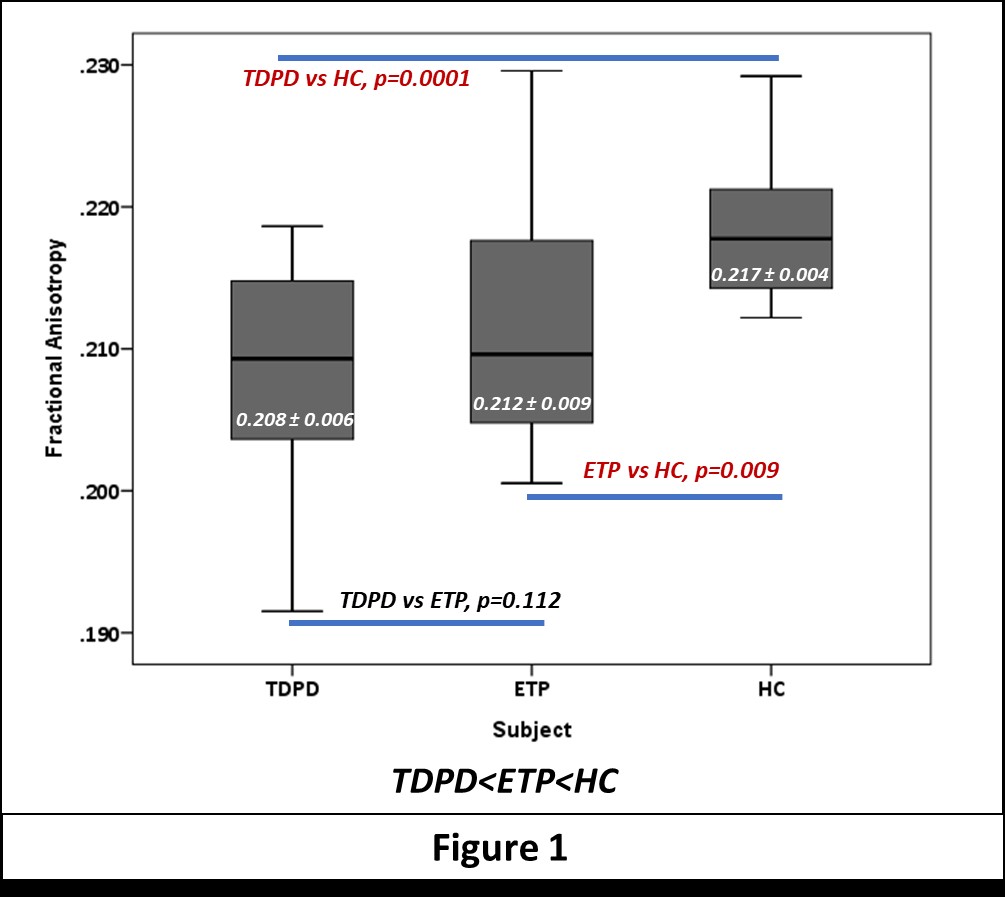Category: Tremor
Objective: To evaluate alterations in fractional anisotropy (FA) of the basal ganglia-thalamocortical (BGTC) and cerebello-thalamocortical (CTC) network in tremor dominant Parkinson’s disease (TDPD) and essential tremor plus (ETP) syndrome.
Background: The BGTC and CTC are implicated in the genesis and propagation of postural and rest tremor, however, the extent of white matter microstructural abnormalities across disorders has not been studied. TDPD and ET are the most commonly encountered tremor dominant neurological disorders. Most studies so far have focused on the BGTC in TDPD and CTC in ET. It is necessary to evaluate the alterations of the tremor network as a single unit to gain new insights into tremorogenesis.
Method: Multi-shell diffusion-weighted images were acquired using a 3T MRI with a 32-channel head coil for 25 patients with TDPD, 25 with ETP and 25 healthy controls (HC). Following this the structural connectomes of the BGTC and CTC were generated by probabilistic tractography The ‘fdt_paths’ file which was generated during probabilistic tractography is the computed tractography mask, i.e., path distribution mask, and was used to compute the FA of the entire tremor network (BGTC and CTC) The path distribution mask was first transformed to FreeSurfer space following which ‘dti_fit’ was run and FA values of the tremor network for individual subjects was obtained. Tremor severity was ascertained using the Fahn-Tolosa-Marin tremor rating scale (FTMRS).
Results: The total FTMRS score between TDPD and ETP was comparable and not significantly different (29.96 ± 11.84 vs 30.08 ± 6.51, p=0.96). FA of the entire tremor network was found to be lower in TDPD in comparison to controls (0.208 ± 0.006 vs 0.217 ± 0.004, p<0.001), and in ETP in comparison to controls (0.212 ± 0.009 vs 0.217 ± 0.004, p<0.001) (Figure-1). However, there was no significant difference between the fractional anisotropy of ETP and TDPD (0.212 ± 0.009 vs 0.208 ± 0.006, p=0.112).
Conclusion: Considering that both groups had the same disease severity as estimated by the FTMRS, the absence of a difference in FA is justifiable. This implies that the extent of damage was reflected in the FA. It is likely that the additional damage in TDPD is associated with other motor symptoms such as bradykinesia and rigidity which are both influenced by damage to the basal ganglia.
To cite this abstract in AMA style:
P. Pal, S. Prasad, R. Bharath, J. Saini. Abnormal fractional anisotropy of the tremor network in tremor dominant Parkinson’s disease and Essential tremor plus syndrome [abstract]. Mov Disord. 2022; 37 (suppl 2). https://www.mdsabstracts.org/abstract/abnormal-fractional-anisotropy-of-the-tremor-network-in-tremor-dominant-parkinsons-disease-and-essential-tremor-plus-syndrome/. Accessed December 25, 2025.« Back to 2022 International Congress
MDS Abstracts - https://www.mdsabstracts.org/abstract/abnormal-fractional-anisotropy-of-the-tremor-network-in-tremor-dominant-parkinsons-disease-and-essential-tremor-plus-syndrome/

